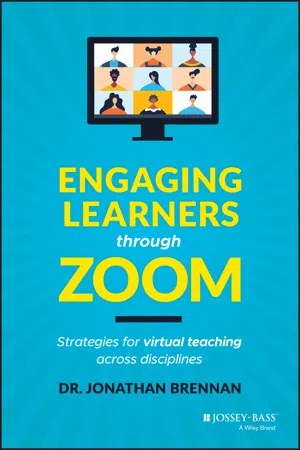
Engaging Learners through Zoom
Strategies for Virtual Teaching Across Disciplines
- English
- ePUB (mobile friendly)
- Available on iOS & Android
About this book
Keep your virtual students focused and meaningfully engaged with this invaluable teaching resource
Engaging Learners through Zoom delivers numerous practical strategies and helpful advice on how to engage students virtually. Many of the tools are also applicable in face-to-face and hybrid environments. Backed by cognitive neuroscience research, this book is a collection of dozens of active, synchronous online learning structures that can be used in any discipline, perfect for middle and high school through higher education.
This book provides teachers, college educators, administrators, and trainers the antidote to Zoom fatigue! Transform Zoom (or any video-conferencing platform) into an ideal environment for students to focus more fully, learn more effectively and have more fun!
Dr. Brennan, accomplished author, professor and distance education expert, improves learner performance and addresses equity in education with:
- Over 150 active learning strategy examples with step-by-step directions
- Ideas for including diverse content across 83 different disciplines
- Multiple examples for 26 of the most commonly taught courses
Engaging Learners through Zoom belongs in the collection of every educator who wants to motivate and inspire their students to excel in a virtual learning environment.
Frequently asked questions
- Essential is ideal for learners and professionals who enjoy exploring a wide range of subjects. Access the Essential Library with 800,000+ trusted titles and best-sellers across business, personal growth, and the humanities. Includes unlimited reading time and Standard Read Aloud voice.
- Complete: Perfect for advanced learners and researchers needing full, unrestricted access. Unlock 1.4M+ books across hundreds of subjects, including academic and specialized titles. The Complete Plan also includes advanced features like Premium Read Aloud and Research Assistant.
Please note we cannot support devices running on iOS 13 and Android 7 or earlier. Learn more about using the app.
Information
CHAPTER 1
Polls
- Account Settings
- Meeting Controls
- Icebreaker Polls
- Starter Polls
- Prediction Polls
- Reflection Polls
- Engagement Polls
- Survey Polls
- Gallery Polls
- Comprehension Polls (Testing Polls)
- Practice Polls
- Closing Polls
- Preventing Issues and Troubleshooting
POLLS
Account Settings
Meeting Controls
1. Icebreaker Polls
Student Role: Which one of the following do you expect to be your biggest challenge in succeeding at college this semester? 1) Managing procrastination, 2) Paying for tuition and textbooks, 3) Handling online classes, 4) Dealing with family and friend issues, or 5) Studying effectively for tests.Academic Topic: Which of these statements do you believe to be true about Quantum Physics?
- Quantum physics is all about uncertainty.
- Almost nobody actually understands quantum physics.
- Quantum physics has led to numerous inventions of practical tools.
- The analogy of Schrödinger's cat is useful in understanding quantum physics.
Fun Topic: If you were a vegetable, which of the following vegetables would you be, and why? 1) Broccoli, 2) Kale, 3) Snow Pea, 4) Cabbage, 5) Spinach, or 6) Green Bean.
2. Starter Polls
Civil Engineering: Which one of the four concrete tests addressed in the textbook reading needs further explanation? 1) Air content, 2) Slump, 3) Compression cylinder, or 4) Flexural beam.Abnormal Psychology: Which condition do you think is most common among the general population in the United States? 1) Phobia, 2) Panic Disorder, 3) Obsessive Compulsive Disorder, 4) Generalized Anxiety Disorder, or 5) Post-Traumatic Stress Disorder.Sociology: Which of these two elements, Role Strain or Role Conflict, presents a greater challenge to your ability to be an effective student in this course? [Role Strain can create overwhelm in managing multiple tasks associated with various student roles: testing, attending class, studying, for example. Role Conflict can create overwhelm when negotiating life roles such as parent, employee, friend, roommate, and so forth.]
3. Prediction Polls
Table of contents
- Cover
- Table of Contents
- Acknowledgments
- About the Author
- Introduction: Zoom and Active Learning Structures
- CHAPTER 1: Polls
- CHAPTER 2: Chat
- CHAPTER 3: Breakout Rooms
- CHAPTER 4: Main Session Room
- CHAPTER 5: Minimizing Zoom Fatigue
- CHAPTER 6: Whiteboards for Sharing
- CHAPTER 7: Virtual Backgrounds and Profile Photos
- CHAPTER 8: Integrating Apps
- Index
- End User License Agreement